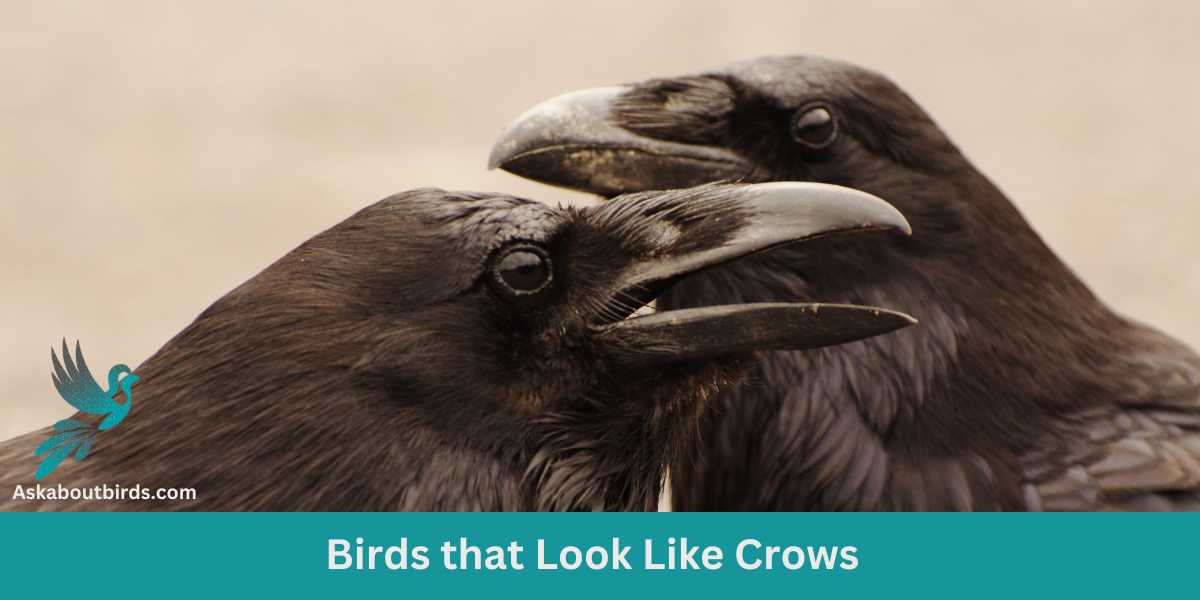Crows are a common sight in many parts of the world, with their distinctive black feathers and raucous calls, the American crow is prevalent in North and South America. However, there are a number of other bird species that resemble crows in appearance, making it difficult for even experienced birdwatchers to tell them apart.
These birds, known as American crow look-alikes, have similar features such as dark blue black feathers, sharp beaks, and intelligent behavior. We explore some of the most common birds that look like crows, from the sleek and shiny Common Raven to the small and nimble Chihuahuan Raven.
List of Birds that look like crows
Corvidae Family (Crows, Jays, and Magpies) – Common Raven, Western Jackdaw, Western Rook, Black-billed Magpie, Alpine Chough, Chihuahuan Raven (same family as American crows)
Icteridae Family (New World Blackbirds and Orioles) – Red-Winged Blackbird, Common Grackle, Brown-Headed Cowbird (common in Southern united states)
Artamidae Family (Woodswallows, Butcherbirds, and Allies) – Pied Currawong (with dark charcoal bodies)
Sturnidae Family (Starlings) – European Starling
Crow


| Feature | Measurement |
|---|---|
| Scientific Name | Corvus brachyrhynchos |
| Length | 16–21 in |
| Wingspan | 33–39 in |
| Weight | 11–21 ounces |
The crow is a common bird found in many parts of the world, known for its distinctive black feathers and cawing call. They are highly intelligent and adaptable, able to thrive in a variety of environments from urban areas to rural forests.
Crows are omnivorous, feeding on a range of foods including insects, small animals, seeds, fruit, and carrion. They are also known to scavenge and steal food from other animals, and have been observed using tools to obtain food.
Crows are known for their intelligence and social behaviors, often forming large flocks and working together to defend their territory or find food. They are also known for their ability to recognize individual humans and remember faces, which has led to them being used in research on animal cognition.
Common Raven

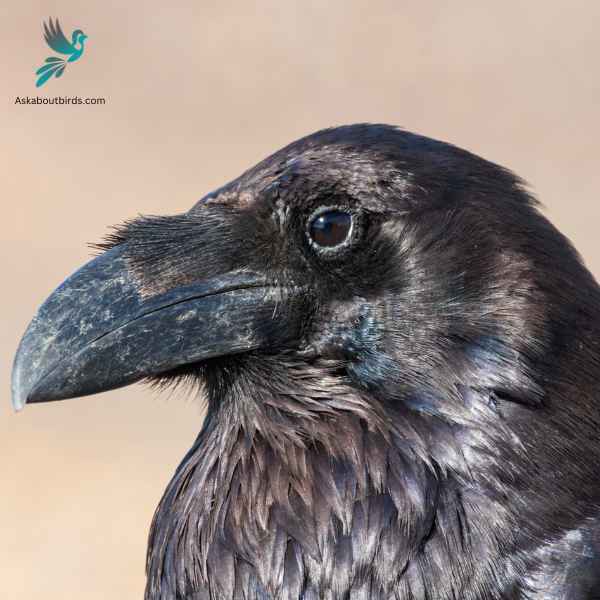
| Feature | Measurement |
|---|---|
| Scientific Name | Corvus corax |
| Length | 21.3-26.4 in |
| Wingspan | 45-51 in |
| Weight | 0.69 to 2 kgs |
The Common Raven is a large, intelligent bird known for its glossy black plumage and its deep, resonating calls. It has a wide distribution and is often associated with myths and legends in various cultures due to its enigmatic nature.
Appearance: Common Ravens are entirely black, from their robust bills to their shaggy throat feathers. Their eyes are dark, and their wingspan is impressive, often mistaken for a hawk or crow. Both males and females share this appearance, though males are typically slightly larger.
Diet: These birds are highly versatile in their diet, feeding on a variety of foods including small mammals, birds, carrion, fruits, grains, and insects. Their adaptability allows them to exploit various food sources depending on availability.
Reproduction: Common Ravens are monogamous and often form long-lasting pair bonds. They typically build large nests made of sticks, often positioned on cliff ledges or high in trees. The female lays a clutch of about 3 to 7 eggs.
Common Raven


| Feature | Measurement |
|---|---|
| Scientific Name | Corvus corax |
| Length | 21.3-26.4 in |
| Wingspan | 45-51 in |
| Weight | 0.69 to 2 kgs |
The Common Raven is a large, intelligent bird known for its glossy black plumage and its deep, resonating calls. It has a wide distribution and is often associated with myths and legends in various cultures due to its enigmatic nature.
Appearance: Common Ravens are entirely black, from their robust bills to their shaggy throat feathers. Their eyes are dark, and their wingspan is impressive, often mistaken for a hawk or crow. Both males and females share this appearance, though males are typically slightly larger.
Diet: These birds are highly versatile in their diet, feeding on a variety of foods including small mammals, birds, carrion, fruits, grains, and insects. Their adaptability allows them to exploit various food sources depending on availability.
Reproduction: Common Ravens are monogamous and often form long-lasting pair bonds. They typically build large nests made of sticks, often positioned on cliff ledges or high in trees. The female lays a clutch of about 3 to 7 eggs.
Common Raven vs Crow
Similarities
- Color: Common Ravens and Crows are entirely black, including their beaks and legs.
- Diet: Both species are omnivorous, eating a wide range of food from insects, grains, berries, to small animals, and even carrion.
- Habitat: Both can adapt to a variety of environments and are widespread, being found in forests, deserts, mountains, and human settlements.
Differences
- Size: The Common Raven is significantly larger than most Crow species, with a heavier bill and a broader wingspan.
- Voice: The call of a Raven is typically a deep, throaty croaking, while Crows often caw loudly.
- Tail Shape: In flight, the tail of a Raven is wedge-shaped, while a Crow’s tail is more squared or slightly rounded.
Chihuahuan Raven


| Feature | Measurement |
|---|---|
| Scientific Name | Corvus cryptoleucus |
| Length | 18–22 in |
| Wingspan | 43–46 in |
| Weight | 7–24 oz |
The Chihuahuan Raven, is a large bird of the crow family found in the southwestern United States and Mexico. They are known for their glossy black feathers and distinctive wedge-shaped tail.
These birds are highly adaptable and can be found in a variety of habitats, from deserts to mountainous regions. They are omnivorous and feed on a variety of food, including insects, small mammals, carrion, and plant matter.
The Chihuahuan Raven is known for its intelligence and problem-solving abilities, which are comparable to those of chimpanzees and dolphins. They have been observed using tools, such as sticks, to obtain food and have been shown to be able to recognize human faces.
The vocalizations of the Chihuahuan Raven are varied and include a range of calls, from deep croaks to high-pitched caws. They are also known to mimic the sounds of other animals, such as dogs and cats.
Chihuahuan Raven vs Crow
Similarities
- Color: Both Chihuahuan Ravens and Crows are entirely black, giving them a similar appearance at first glance.
- Diet: Both species are omnivorous, feeding on a variety of foods like insects, grains, small animals, and carrion.
- Habitat: Both species can adapt to a wide variety of environments, including desert scrub, prairies, and agricultural areas.
Differences
- Size: The Chihuahuan Raven is generally larger than many species of Crows, though it is smaller than the Common Raven.
- Voice: The Chihuahuan Raven’s call is typically a nasal “pruk-pruk” or a throaty “r-r-r-r-ruck”, differing from the common caw of Crows.
- Range: The Chihuahuan Raven is primarily found in the Southwestern United States and Mexico, a distribution that may help distinguish it from various Crow species that have wider or different ranges.
Red-Winged Blackbird
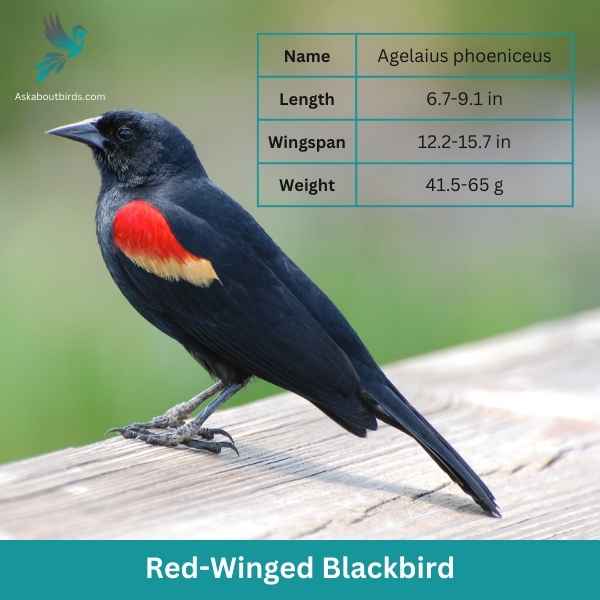
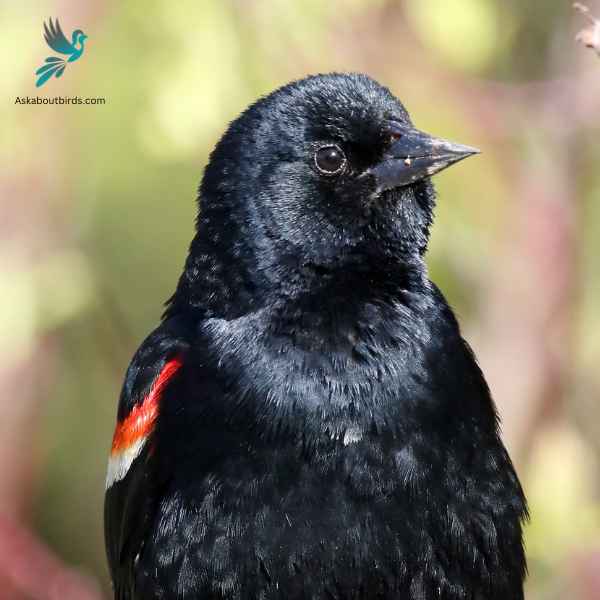
| Feature | Measurement |
|---|---|
| Scientific Name | Agelaius phoeniceus |
| Length | 6.7-9.1 in |
| Wingspan | 12.2-15.7 in |
| Weight | 41.5-65 g |
The Red-Winged Blackbird is a familiar sight across North America, especially in wetlands and open areas. Known for its striking coloration and distinct call, it is often seen perched on cattails or utility lines.
Appearance: Male Red-Winged Blackbirds are glossy black with bright red-and-yellow shoulder patches, while females are streaky brown, resembling a large sparrow. The males’ red patches become more prominent when they’re displaying or agitated.
Diet: Red-Winged Blackbirds primarily feed on seeds and insects. Their diet includes grains, sunflower seeds, and corn, but they also eat beetles, caterpillars, and other small invertebrates, especially in the breeding season.
Reproduction: Red-Winged Blackbirds nest in marshes, along watercourses, and in wet fields. The female constructs a cup-shaped nest using grass and sedge, attaching it to plants above water. She typically lays a clutch of 3 to 4 blue-green eggs, which she incubates for about 11-12 days. Males, being polygynous, often have multiple mates during a single breeding season.
Red-Winged Blackbird vs Crow
Similarities
- Color: Both Red-Winged Blackbirds (males) and Crows have predominantly black plumage.
- Diet: Both species are omnivorous, consuming a wide variety of foods including seeds, grains, insects, and small invertebrates.
- Habitat: Both birds can be found in a wide variety of environments, including marshes, pastures, and even urban parks or gardens.
Differences
- Size: Red-Winged Blackbirds are smaller than most Crow species.
- Color Patterns: While both are predominantly black, male Red-Winged Blackbirds have distinctive red and yellow shoulder patches, a feature absent in Crows.
- Voice: Red-Winged Blackbirds have a distinctive, musical call that is very different from the familiar cawing of Crows.
Common Grackle

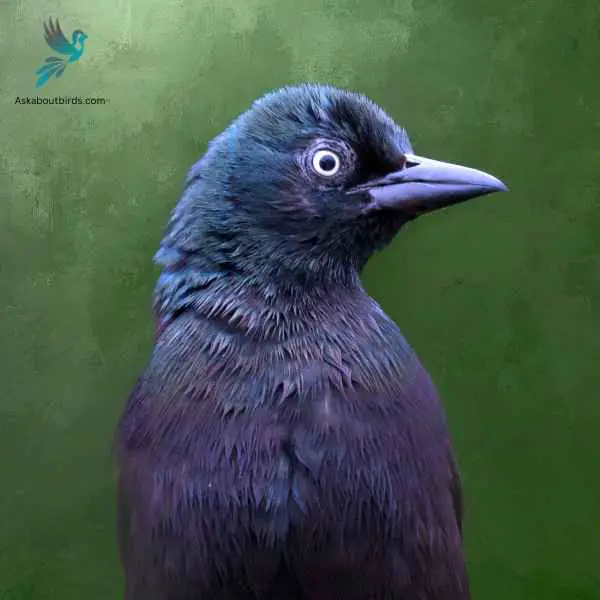
| Feature | Measurement |
|---|---|
| Scientific Name | Quiscalus quiscula |
| Length | 11 to 13 in |
| Wingspan | 14–18 in |
| Weight | 74–142 g |
The Common Grackle is a conspicuous bird found across much of North America, recognized for its glossy-black plumage, long tail, and piercing yellow eyes. Its vocalizations are varied and include a range of harsh, grating calls.
Appearance: The Common Grackle has a sleek black body with a glossy-iridescent sheen that can appear purple, green, or blue in certain lights. Its tail is long and keel-shaped. While both males and females have similar coloration, males are noticeably larger and shinier than females.
Diet: Common Grackles are omnivores. They primarily consume seeds, berries, and insects. However, they are also known to eat small fish, amphibians, and other birds’ eggs, especially when foraging on the ground or in shallow water.
Reproduction: Common Grackles breed in open and semi-open areas. The female typically selects the nest site and constructs a bulky nest made of grasses, twigs, and other plant materials, often in shrubs or trees. She lays a clutch of about 1 to 7 eggs, which are pale blue and spotted with brown.
Common Grackle vs Crow
Similarities
- Color: Both the Common Grackle and Crows are predominantly black, though lighting conditions can reveal more color in Grackles.
- Diet: Both species are omnivorous, feeding on a wide array of foods including insects, grains, fruits, small animals, and even human food waste.
- Habitat: Both birds can adapt to a variety of environments, including forests, farmlands, suburban, and urban areas.
Differences
- Size: The Common Grackle is generally smaller than most Crow species.
- Color Variance: While both birds are predominantly black, the Common Grackle often displays an iridescent sheen with tones of blue, purple, or bronze, particularly on its body and head. Crows, on the other hand, are usually just black.
- Tail Shape: The Grackle’s tail is significantly longer proportionally, and it often appears V-shaped or keel-shaped, especially in flight. A Crow’s tail is more squared or slightly rounded.
Brown-Headed Cowbird
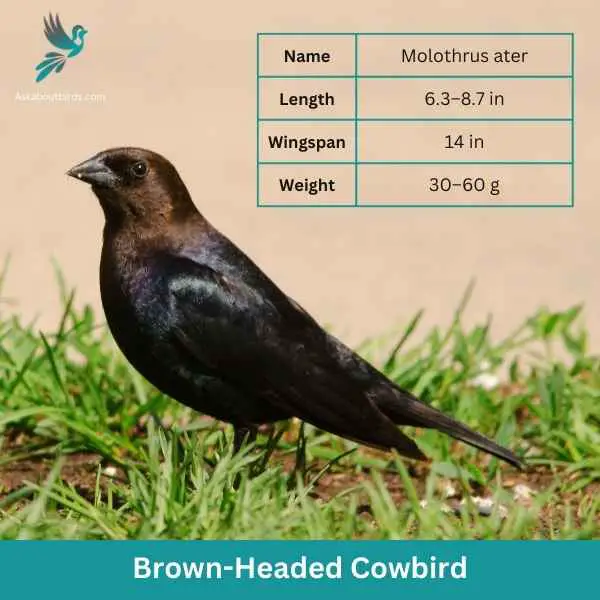

| Feature | Measurement |
|---|---|
| Scientific Name | Molothrus ater |
| Length | 6.3–8.7 in |
| Wingspan | 14 in |
| Weight | 30–60 g |
The Brown-Headed Cowbird is a unique North American bird known for its brood parasitism behavior. Rather than building its own nests, it lays its eggs in the nests of other bird species.
Appearance: Male Brown-Headed Cowbirds are glossy black with a distinct brown head, while females are plain gray-brown without the brown head. Both have a stout shape with a finch-like bill and a short tail.
Diet: Brown-Headed Cowbirds primarily feed on seeds, including grasses and grains. They also consume insects, especially during the breeding season. These birds often forage on the ground, commonly seen in open habitats like fields or pastures.
Reproduction: Unique among North American birds, the Brown-Headed Cowbird is a brood parasite. Instead of building its own nest, the female lays her eggs in the nests of other bird species. The unwitting host then raises the cowbird chick, often at the expense of its own offspring. The female can lay up to 40 eggs in a single breeding season, spread across multiple host nests.
Brown-Headed Cowbird vs Crow
Similarities
- Diet: Both the Brown-Headed Cowbird and Crows are omnivorous, consuming a wide variety of foods, from insects and seeds to fruits and small invertebrates.
- Habitat: Both species are highly adaptable and can thrive in a variety of environments, including farmlands, forests, and suburban areas.
- Breeding Behavior: Both species lay their eggs in the nests of other birds, a behavior known as brood parasitism, although this is far more common in Brown-Headed Cowbirds.
Differences
- Size: The Brown-Headed Cowbird is considerably smaller than most Crow species.
- Coloration: Male Brown-Headed Cowbirds have a distinctive brown head, contrasting with their black body. Crows, on the other hand, are entirely black.
- Song: The song of a Brown-Headed Cowbird is a series of gurgling notes followed by a squeaky sound, which is quite different from the cawing sounds made by Crows.
Western Jackdaw
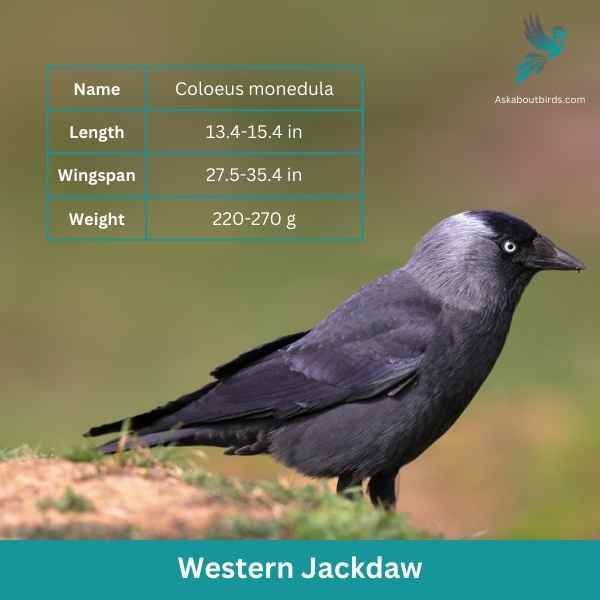
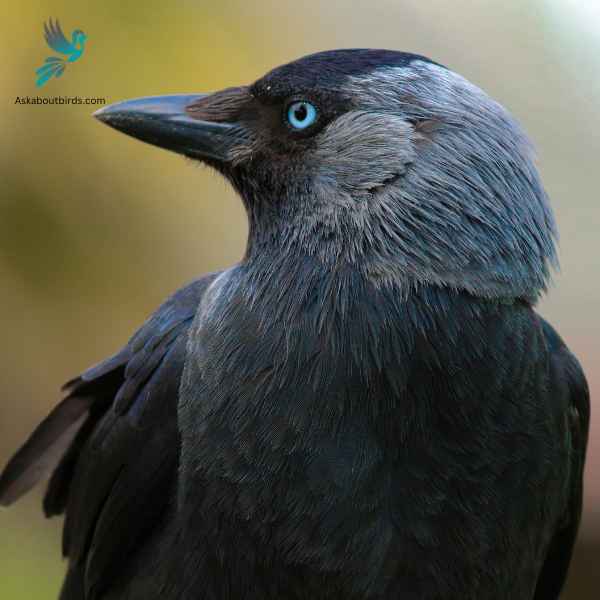
| Feature | Measurement |
|---|---|
| Scientific Name | Coloeus monedula |
| Length | 13.4-15.4 in |
| Wingspan | 27.5-35.4 in |
| Weight | 220-270 g |
The Western Jackdaw is a sociable and intelligent bird, widely recognized for its playful nature and strong affiliation with urban environments.
Appearance: Western Jackdaws are relatively small, with a glossy black plumage that adorns most of their body. However, the sides of their head and nape are light grey. Their striking pale eyes are another distinguishing feature.
Diet: Primarily omnivorous, Western Jackdaws feed on a wide range of items. They prefer seeds, fruits, and insects, but their adaptable nature means they often scavenge for scraps in urban settings, including leftover human foods.
Reproduction: Western Jackdaws are monogamous, often forming bonds that last a lifetime. They prefer to nest in cavities, be it natural ones in trees or man-made structures like chimneys. The female typically lays a clutch of 4 to 6 eggs, which both parents help incubate and raise.
Western Jackdaw vs Crow
Similarities
- Color: Both Western Jackdaws and Crows have predominantly black plumage, contributing to their similar appearance.
- Diet: Both species are omnivorous, consuming a wide range of food items like insects, seeds, fruits, and even carrion.
- Habitat: Both birds can adapt to a variety of environments, including forests, farmlands, and urban areas.
Differences
- Size: The Western Jackdaw is smaller than most Crow species, being one of the smallest species in the crow family.
- Eye Color: Western Jackdaws have light-colored eyes, usually pale blue or grey, while Crows have dark eyes.
- Voice: The call of a Western Jackdaw is a distinctive “jack-jack”, which is quite different from the cawing sounds made by Crows.
Pied Currawong vs Crow
Similarities
- Color: Both Pied Currawongs and Crows are predominantly black, adding to their similar appearance.
- Diet: Both species are omnivorous, consuming a broad range of foods, from insects and small animals to fruits and seeds.
- Habitat: Both birds can adapt to various environments, including forests, woodlands, and suburban areas.
Differences
- Size: The Pied Currawong is typically smaller than most Crow species.
- Color Variation: The Pied Currawong has white patches on the wings and the base of the tail, distinguishing them from the typically all-black Crows.
- Voice: The call of a Pied Currawong is a loud “curra-wong”, which is distinct from the cawing sounds made by Crows.
Western Rook


| Feature | Measurement |
|---|---|
| Scientific Name | Corvus frugilegus |
| Length | 17.7-18.5 in |
| Wingspan | 31.5-41.3 in |
| Weight | 337-452 g |
The Western Rook (Corvus frugilegus) is a member of the crow family recognized for its gregarious nature and impressive adaptability. This bird is almost entirely black, with a slightly purplish gloss on its plumage visible in certain lighting. One distinguishing feature is its bare, greyish-white face around the base of its bill, which gives it an appearance different from other crows. The Western Rook’s strong, pointed bill is particularly well-suited to its largely granivorous diet.
Native to Europe and western Asia, the Western Rook is typically found in agricultural and open habitats, where it can often be seen in large flocks foraging on farmland. Its diet primarily consists of invertebrates, plant material, and agricultural grains, but it is highly opportunistic and will consume almost any food items available. Although the species is currently of least concern, changes in agricultural practices can impact their food supply, making ongoing monitoring and habitat management essential to their conservation.
Western Rook vs Crow
Similarities
- Color: Both Western Rooks and Crows have predominantly black plumage, contributing to their similar appearance from a distance.
- Diet: Both species are omnivorous, feeding on a variety of food items, including insects, seeds, grains, fruits, and small animals.
- Habitat: Both birds can be found in diverse habitats, including farmlands, woodlands, and urban areas.
Differences
- Size: The Western Rook is typically similar in size to the Carrion Crow, but size variations can occur among individuals and populations.
- Bill Shape: The Western Rook has a slightly more slender and curved bill compared to the straighter bill of a typical Crow.
- Behavior: Western Rooks are often more social, forming large flocks and roosting together, while Crows are typically seen in smaller groups or pairs.
Black-Billed Magpie


| Feature | Measurement |
|---|---|
| Scientific Name | Pica hudsonia |
| Length | 13.4-15.4 in |
| Wingspan | 27.5-35.4 in |
| Weight | 220-270 g |
The Black-Billed Magpie is a striking bird native to the western half of North America, recognized for its bold black and white plumage and long tail. Its vocalizations are varied, including harsh chatters and melodious notes, and it’s known to be both curious and intelligent.
Appearance: The Black-Billed Magpie has a unique appearance with its glossy black head, chest, and tail contrasting sharply against its white belly and shoulder patches. Its long tail, which is iridescent greenish-blue, is one of its most distinguishing features. The wings also display a hint of iridescent blue-green.
Diet: Black-Billed Magpies are omnivorous and have a diverse diet. They primarily eat insects, especially in summer, but will also consume small mammals, berries, seeds, and carrion. They are often seen scavenging roadkill and are known to store food in the ground for later consumption.
Reproduction: Black-Billed Magpies mate monogamously and usually build large, domed nests in trees or large shrubs. These nests are made from twigs and mud and can be quite elaborate. The female lays a clutch of about 6 to 9 eggs, which are greenish or bluish and speckled with brown.
Black-billed Magpie vs Crow
Similarities
- Color: Both the Black-Billed Magpie and Crows have predominantly black plumage, although the Magpie often has additional white markings on its wings, tail, and belly.
- Diet: Both species are omnivorous, feeding on a variety of foods, including insects, small animals, fruits, seeds, and carrion.
- Habitat: Both birds can adapt to various habitats, including forests, woodlands, open fields, and urban areas.
Differences
- Size: The Black-Billed Magpie is generally slightly smaller than most Crow species.
- Distinctive Markings: The Black-Billed Magpie has white markings on its wings, tail, and belly, whereas Crows are typically all black.
- Behavior and Calls: Black-Billed Magpies are known for their vocal nature and complex vocalizations, including a range of chattering and melodic calls, which differ from the cawing sounds made by Crows.
Alpine Chough


| Feature | Measurement |
|---|---|
| Scientific Name | Pyrrhocorax graculus |
| Length | 4.7–5.5 in |
| Wingspan | 30–33 in |
| Weight | 191–244 g |
The Alpine Chough (Pyrrhocorax graculus), also known as Yellow-Billed Chough, is a distinctive bird species belonging to the crow family. It is known for its glossy black plumage, contrasting bright yellow bill, and red legs. Its acrobatic flight displays and high-pitched calls distinguish it in its alpine environment. Unlike most other crows, the Alpine Chough shows a preference for high altitudes, often nesting on rocky cliff faces and foraging in alpine meadows.
The species is widely distributed across mountain ranges of Southern Europe, the Alps, and Central Asia, reaching altitudes of up to 4,000 meters or even higher. Alpine Choughs have a varied diet that includes invertebrates, seeds, fruits, and are also known to scavenge from human sources. They are highly social birds that often feed, roost, and fly in large flocks. Although currently not threatened, they could face future challenges due to climate change and alterations in land use affecting their high-altitude habitats. Therefore, ongoing monitoring and conservation efforts remain crucial.
Alpine Chough vs Crow
Similarities
- Color: Both Alpine Choughs and Crows have predominantly black plumage, giving them a similar appearance from a distance.
- Diet: Both species are omnivorous, feeding on a range of food items including insects, seeds, fruits, and small animals.
- Habitat: Both birds can adapt to various environments, including alpine regions, mountains, and rocky areas.
Differences
- Size: Alpine Choughs are generally smaller than most Crow species.
- Beak and Legs: Alpine Choughs have distinctive bright red beaks and legs, whereas Crows typically have black beaks and legs.
- Behavior and Habitat: Alpine Choughs are well-adapted to high-altitude environments and are known for their acrobatic flight and group formations, while Crows tend to have more varied habitats and flight patterns.
European Starling
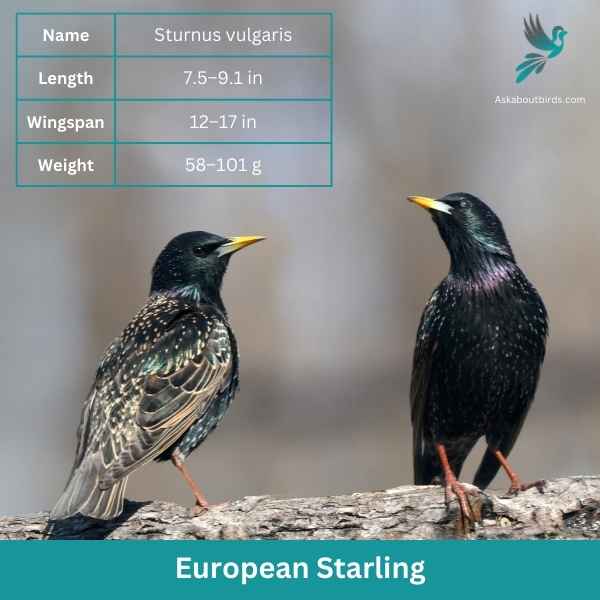

| Feature | Measurement |
|---|---|
| Scientific Name | Sturnus vulgaris |
| Length | 7.5–9.1 in |
| Wingspan | 12–17 in |
| Weight | 58–101 g |
The European Starling is a highly adaptable bird, recognized for its iridescent plumage and uncanny ability to mimic a variety of sounds, from other birds to mechanical noises.
Appearance: European Starlings showcase glossy black feathers with a purple or green sheen, especially prominent during the breeding season. Their winter plumage is speckled with white dots. Both males and females have a similar appearance, but juveniles are gray-brown overall until their first winter.
Diet: These birds are omnivorous, consuming a wide range of foods. Their diet includes insects, seeds, fruits, and occasionally even small vertebrates. European Starlings are known to forage in groups, often seen probing the ground with their strong, pointed bills.
Reproduction: European Starlings are cavity nesters, selecting sites such as holes in trees, buildings, or other structures. After a courtship display that involves singing and wing-flapping, the female lays a clutch of about 4 to 6 eggs
European Starling vs Crow
Similarities
- Color: Both European Starlings and Crows have predominantly dark-colored plumage, with the Starling displaying iridescent black feathers that can appear glossy.
- Diet: Both species are omnivorous, feeding on a wide range of foods, including insects, fruits, seeds, and even scavenging for carrion.
- Habitat: Both birds are adaptable and can be found in various habitats, including urban areas, farmlands, and open woodlands.
Differences
- Size: European Starlings are typically smaller than most Crow species.
- Flight Patterns: Starlings are known for their agile and acrobatic flight, often flying in large flocks that perform synchronized aerial displays called murmurations. Crows have a more direct and less synchronized flight pattern.
- Vocalizations: European Starlings are highly vocal birds, capable of mimicking a wide range of sounds including other bird songs, human speech, and environmental noises. Crows have a distinct cawing call that is different from the varied vocal repertoire of Starlings.

